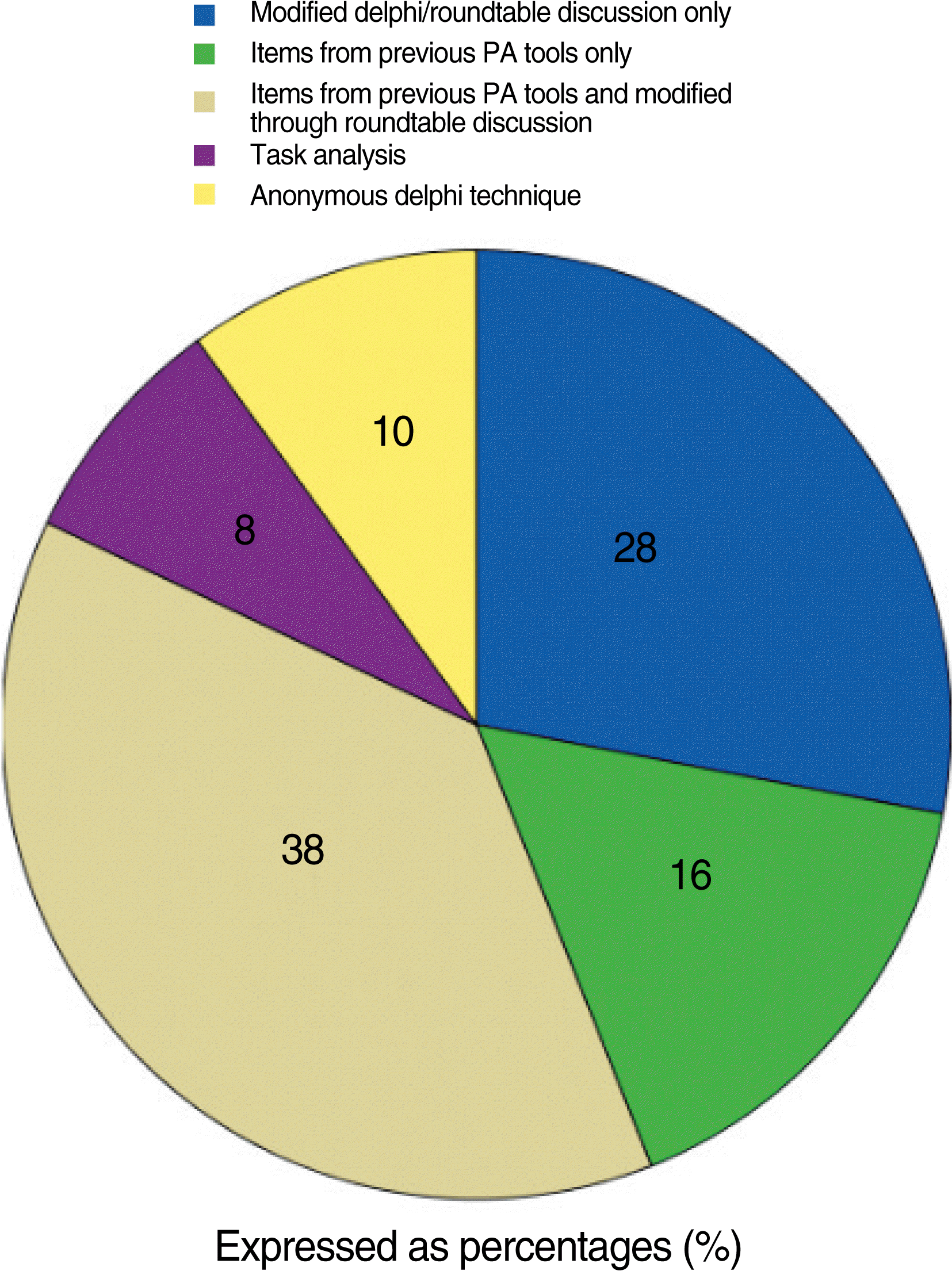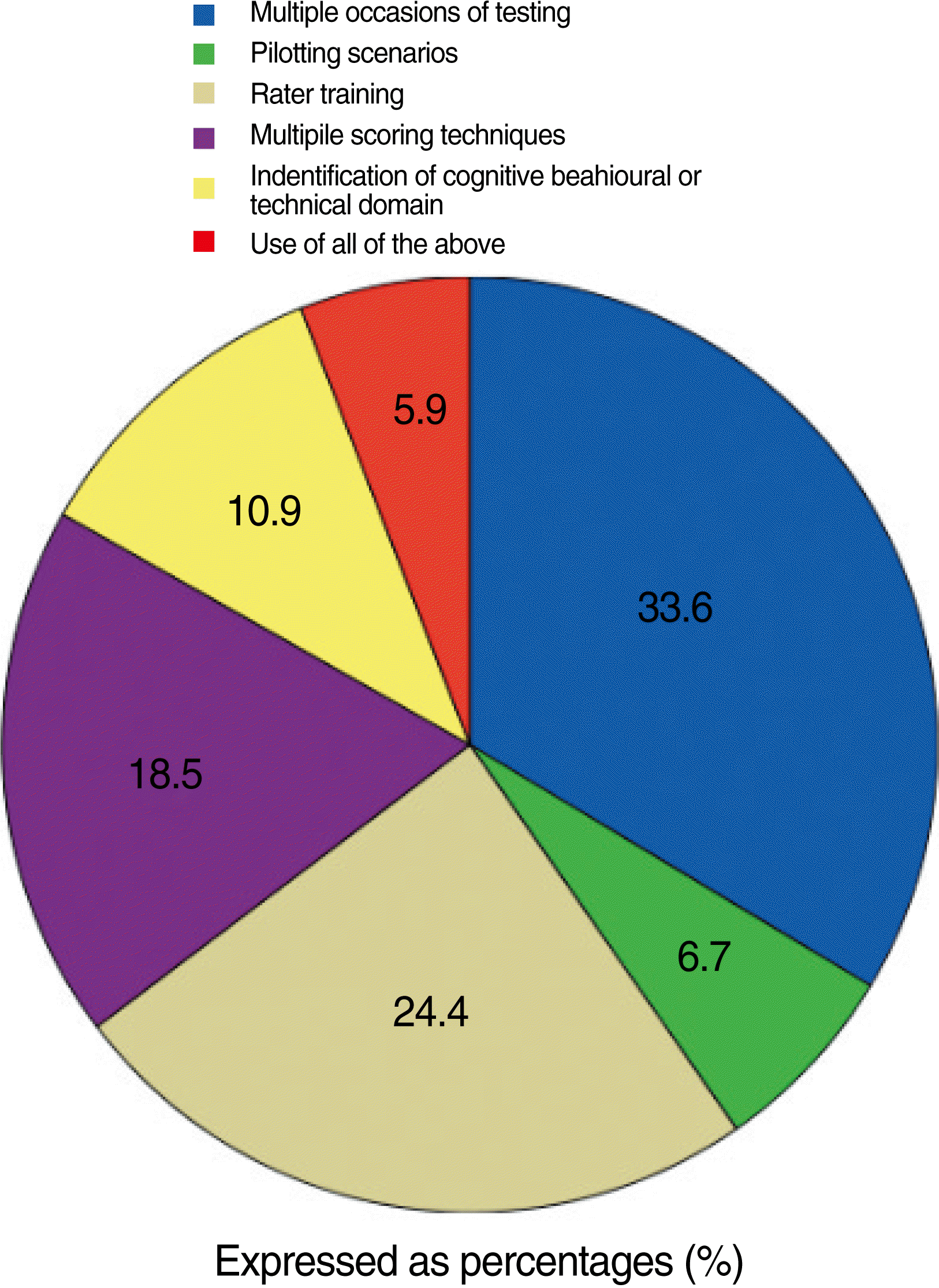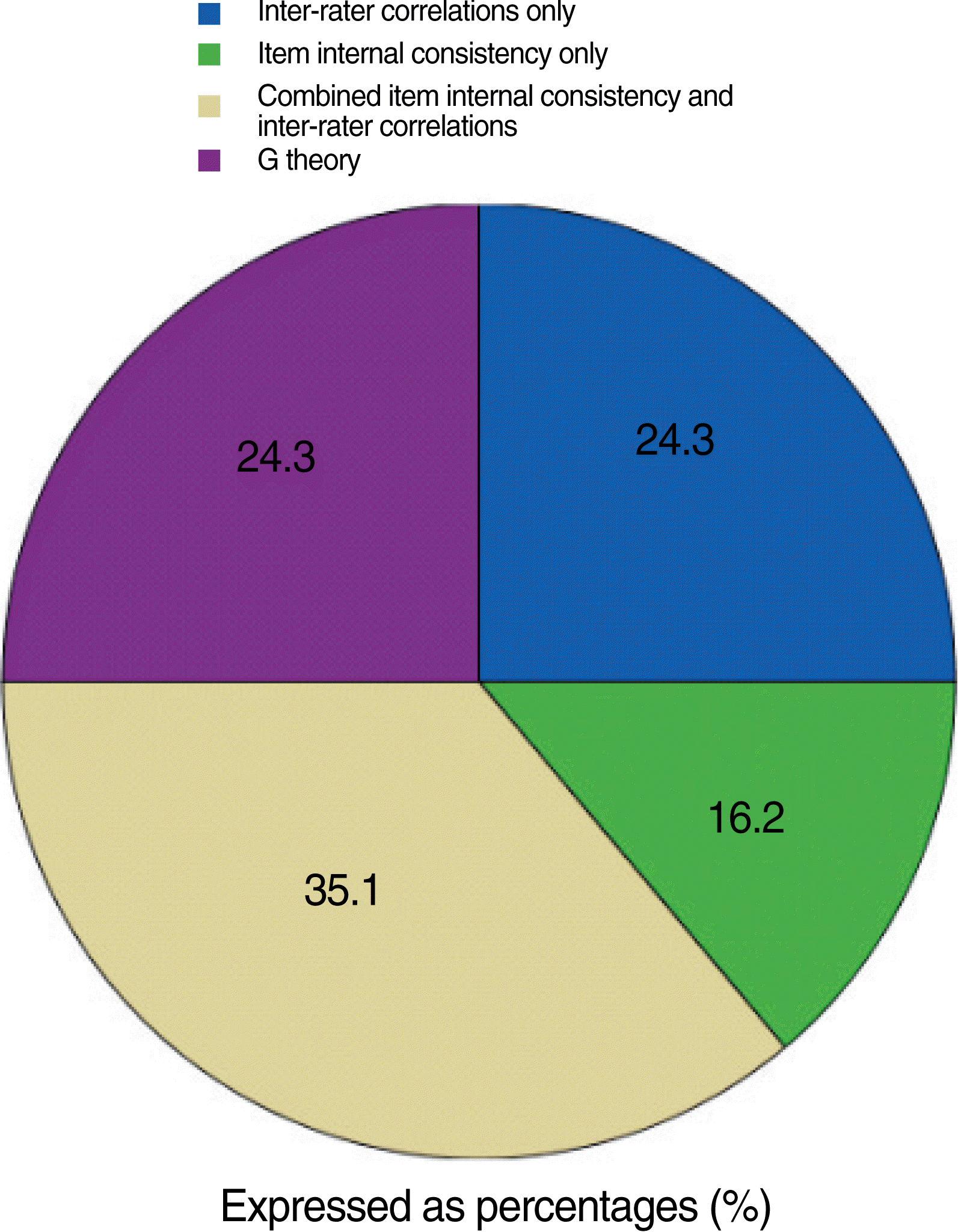1. Thorndike EL. An introduction to the theory of mental and social measurement. New York: Science Press;1904.
2. Epstein RM, Hundert EM. Defining and assessing professional competence. JAMA. 2002; 287:226–35.

3. McClelland DC. Testing for competence rather than for “intelligence”. Am Psychol. 1973; 28:1–14.

4. Accreditation Council for Graduate Medical Education. Outcomes Project [Internet]. Chicago (IL): Accreditation Council for Graduate Medical Education;c2009. [cited 2009 Jan 20]. Available from:
http://www.acgme.org/outcome/.
5. Tetzlaff JE. Assessment of competency in anesthesiology. Anesthesiology. 2007; 106:812–25.

6. Bland CJ, Meurer LN, Maldonado G. A systematic approach to conducting a non-statistical meta-analysis of research literature. Acad Med. 1995; 70:642–53.

7. Slavin RE. Perspectives on evidence-based research in education: What works? Issues in synthesizing educational program evaluations. Educ Res. 2008; 37:5–14.
8. Fritz PZ, Gray T, Flanagan B. Review of mannequin-based high-fidelity simulation in emergency medicine. Emerg Med Australas. 2008; 20:1–9.

9. Howard SK, Gaba DM, Fish KJ, Yang G, Sarnquist FH. Anesthesia crisis resource management training: teaching anesthesiologists to handle critical incidents. Aviat Space Environ Med. 1992; 63:763–70.
10. Crocker LM, Algina J. Introduction to classical and modern test theory. 2nd ed. Victoria: Thomson Wadsworth;2006.
11. Berkenstadt H, Kantor GS, Yusim Y, et al. The feasibility of sharing simulation-based evaluation scenarios in anesthesiology. Anesth Analg. 2005; 101:1068–74.

12. Berkenstadt H, Ziv A, Gafni N, Sidi A. The validation process of incorporating simulation-based accreditation into the anesthesiology Israeli national board exams. Isr Med Assoc J. 2006; 8:728–33.
13. Blike GT, Christoffersen K, Cravero JP, Andeweg SK, Jensen J. A method for measuring system safety and latent errors associated with pediatric procedural sedation. Anesth Analg. 2005; 101:48–58.

14. Blum RH, Raemer DB, Carroll JS, Dufresne RL, Cooper JB. A method for measuring the effectiveness of simulation-based team training for improving communication skills. Anesth Analg. 2005; 100:1375–80.
15. Boulet JR, Murray D, Kras J, Woodhouse J, McAllister J, Ziv A. Reliability and validity of a simulation-based acute care skills assessment for medical students and residents. Anesthesiology. 2003; 99:1270–80.

16. Boulet JR, Marray D, Kras J, Woodhouse J. Setting performance standards for mannequin-based acute-care scenarios: an examineecentered approach. Simul Healthc. 2008; 3:72–81.
17. Byrne AJ, Jones JG. Responses to simulated anaesthetic emergencies by anaesthetists with different durations of clinical experience. Br J Anaesth. 1997; 78:553–6.

18. Byrne AJ, Sellen AJ, Jones JG. Errors on anaesthetic record charts as a measure of anaesthetic performance during simulated critical incidents. Br J Anaesth. 1998; 80:58–62.

19. Chopra V, Gesink BJ, de Jong J, Bovill JG, Spierdijk J, Brand R. Does training on an anaesthesia simulator lead to improvement in performance? Br J Anaesth. 1994; 73:293–7.

20. Devitt JH, Kurrek MM, Cohen MM, Cleave-Hogg D. The validity of performance assessments using simulation. Anesthesiology. 2001; 95:36–42.

21. Devitt JH, Kurrek MM, Cohen MM, et al. Testing the raters: interrater reliability of standardized anaesthesia simulator performance. Can J Anaesth. 1997; 44:924–8.

22. Devitt JH, Kurrek MM, Cohen MM, et al. Testing internal consistency and construct validity during evaluation of performance in a patient simulator. Anesth Analg. 1998; 86:1160–4.

23. Farnsworth ST, Egan TD, Johnson SE, Westenskow D. Teaching sedation and analgesia with simulation. J Clin Monit Comput. 2000; 16:273–85.
24. Fletcher G, Flin R, McGeorge P, Glavin R, Maran N, Patey R. Anaesthetists’ Non-Technical Skills (ANTS): evaluation of a behavioural marker system. Br J Anaesth. 2003; 90:580–8.
25. Forrest FC, Taylor MA, Postlethwaite K, Aspinall R. Use of a highfidelity simulator to develop testing of the technical performance of novice anaesthetists. Br J Anaesth. 2002; 88:338–44.

26. Gaba DM, DeAnda A. The response of anesthesia trainees to simulated critical incidents. Anesth Analg. 1989; 68:444–51.

27. Gaba DM, Howard SK, Flanagan B, Smith BE, Fish KJ, Botney R. Assessment of clinical performance during simulated crises using both technical and behavioral ratings. Anesthesiology. 1998; 89:8–18.

28. Harrison TK, Manser T, Howard SK, Gaba DM. Use of cognitive aids in a simulated anesthetic crisis. Anesth Analg. 2006; 103:551–6.

29. Howard SK, Gaba DM, Smith BE, et al. Simulation study of rested versus sleep-deprived anesthesiologists. Anesthesiology. 2003; 98:1345–55.

30. Hunt EA, Walker AR, Shaffner DH, Miller MR, Pronovost PJ. Simulation of in-hospital pediatric medical emergencies and cardiopulmonary arrests: highlighting the importance of the first 5 minutes. Pediatrics. 2008; 121:e34–43.

31. Jacobsen J, Lindekaer AL, Ostergaard HT, et al. Management of anaphylactic shock evaluated using a full-scale anaesthesia simulator. Acta Anaesthesiol Scand. 2001; 45:315–9.

32. Johnson KB, Syroid ND, Drews FA, et al. Part Task and variable priority training in first-year anesthesia resident education: a combined didactic and simulation-based approach to improve management of adverse airway and respiratory events. Anesthesiology. 2008; 108:831–40.
33. Lorraway PG, Savoldelli GL, Joo HS, Chandra DB, Chow R, Naik VN. Management of simulated oxygen supply failure: is there a gap in the curriculum? Anesth Analg. 2006; 102:865–7.

34. Morgan PJ, Cleave-Hogg D. Evaluation of medical students’ performances using the anesthesia simulator. Acad Med. 1999; 74:202.

35. Morgan PJ, Cleave-Hogg D. Evaluation of medical students’ performance using the anaesthesia simulator. Med Educ. 2000; 34:42–5.

36. Morgan PJ, Cleave-Hogg D, Desousa S, Lam-McCulloch J. Applying theory to practice in undergraduate education using high fidelity simulation. Med Teach. 2006; 28:e10–5.

37. Morgan PJ, Cleave-Hogg D, DeSousa S, Tarshis J. Identification of gaps in the achievement of undergraduate anesthesia educational objectives using high-fidelity patient simulation. Anesth Analg. 2003; 97:1690–4.

38. Morgan PJ, Cleave-Hogg D, DeSousa S, Tarshis J. High-fidelity patient simulation: validation of performance checklists. Br J Anaesth. 2004; 92:388–92.

39. Morgan PJ, Cleave-Hogg D, Guest CB. A comparison of global ratings and checklist scores from an undergraduate assessment using an anesthesia simulator. Acad Med. 2001; 76:1053–5.

40. Morgan PJ, Cleave-Hogg DM, Guest CB, Herold J. Validity and reliability of undergraduate performance assessments in an anesthesia simulator. Can J Anaesth. 2001; 48:225–33.

41. Morgan PJ, Pittini R, Regehr G, Marrs C, Haley MF. Evaluating teamwork in a simulated obstetric environment. Anesthesiology. 2007; 106:907–15.

42. Murray D, Boulet J, Ziv A, Woodhouse J, Kras J, McAllister J. An acute care skills evaluation for graduating medical students: a pilot study using clinical simulation. Med Educ. 2002; 36:833–41.

43. Murray DJ, Boulet JR, Avidan M, et al. Performance of residents and anesthesiologists in a simulation-based skill assessment. Anesthesiology. 2007; 107:705–13.

44. Murray DJ, Boulet JR, Kras JF, McAllister JD, Cox TE. A simulation-based acute skills performance assessment for anesthesia training. Anesth Analg. 2005; 101:1127–34.

45. Murray DJ, Boulet JR, Kras JF, Woodhouse JA, Cox T, McAllister JD. Acute care skills in anesthesia practice: a simulation-based resident performance assessment. Anesthesiology. 2004; 101:1084–95.
46. Olympio MA, Whelan R, Ford RP, Saunders IC. Failure of simulation training to change residents’ management of oesophageal intubation. Br J Anaesth. 2003; 91:312–8.
47. Ringsted C, Ostergaard D, Ravn L, Pedersen JA, Berlac PA, van der Vleuten CP. A feasibility study comparing checklists and global rating forms to assess resident performance in clinical skills. Med Teach. 2003; 25:654–8.

48. Rosenblatt MA, Abrams KJ. The use of a human patient simulator in the evaluation of and development of a remedial prescription for an anesthesiologist with lapsed medical skills. Anesth Analg. 2002; 94:149–53.

49. Savoldelli GL, Naik VN, Joo HS, et al. Evaluation of patient simulator performance as an adjunct to the oral examination for senior anesthesia residents. Anesthesiology. 2006; 104:475–81.

50. Scavone BM, Sproviero MT, McCarthy RJ, et al. Development of an objective scoring system for measurement of resident performance on the human patient simulator. Anesthesiology. 2006; 105:260–6.

51. Schwid HA, O’Donnell D. Anesthesiologists’ management of simulated critical incidents. Anesthesiology. 1992; 76:495–501.

52. Schwid HA, Rooke GA, Carline J, et al. Evaluation of anesthesia residents using mannequin-based simulation: a multiinstitutional study. Anesthesiology. 2002; 97:1434–44.
53. Schwid HA, Rooke GA, Ross BK, Sivarajan M. Use of a computerized advanced cardiac life support simulator improves retention of advanced cardiac life support guidelines better than a textbook review. Crit Care Med. 1999; 27:821–4.

54. Steadman RH, Coates WC, Huang YM, et al. Simulation-based training is superior to problem-based learning for the acquisition of critical assessment and management skills. Crit Care Med. 2006; 34:151–7.

55. Weller J, Merry A, Warman G, Robinson B. Anaesthetists’ management of oxygen pipeline failure: room for improvement. Anaesthesia. 2007; 62:122–6.

56. Weller JM, Bloch M, Young S, et al. Evaluation of high fidelity patient simulator in assessment of performance of anaesthetists. Br J Anaesth. 2003; 90:43–7.

57. Weller JM, Jolly B, Robinson B. Generalisability of behavioural skills in simulated anaesthetic emergencies. Anaesth Intensive Care. 2008; 36:185–9.

58. Weller JM, Robinson BJ, Jolly B, et al. Psychometric characteristics of simulation-based assessment in anaesthesia and accuracy of selfassessed scores. Anaesthesia. 2005; 60:245–50.

59. Wheeler DW, Degnan BA, Murray LJ, et al. Retention of drug administration skills after intensive teaching. Anaesthesia. 2008; 63:379–84.

60. Yee B, Naik VN, Joo HS, et al. Nontechnical skills in anesthesia crisis management with repeated exposure to simulation-based education. Anesthesiology. 2005; 103:241–8.

61. Cronbach LJ, Meehl PE. Construct validity in psychological tests. Psychol Bull. 1955; 52:281–302.

62. Shavelson RJ, Webb NM. Generalizability theory: a primer. Newbury Park: Sage Publications Inc;1991.
63. Wigdor AK, Green BF. Performance assessment for the workplace. Washington (DC): National Academy Press;1991.
64. Hravnak M, Tuite P, Baldisseri M. Expanding acute care nurse practitioner and clinical nurse specialist education: invasive procedure training and human simulation in critical care. AACN Clin Issues. 2005; 16:89–104.
65. Kurrek MM, Devitt JH. The cost for construction and operation of a simulation centre. Can J Anaesth. 1997; 44:1191–5.

66. Lampotang S, Good ML, Westhorpe R, Hardcastle J, Carovano RG. Logistics of conducting a large number of individual sessions with a full-scale patient simulator at a scientific meeting. J Clin Monit. 1997; 13:399–407.
67. Seropian MA. General concepts in full scale simulation: getting started. Anesth Analg. 2003; 97:1695–705.

68. Tuoriniemi P, Schott-Baer D. Implementing a high-fidelity simulation program in a community college setting. Nurs Educ Perspect. 2008; 29:105–9.





 PDF
PDF Citation
Citation Print
Print





 XML Download
XML Download